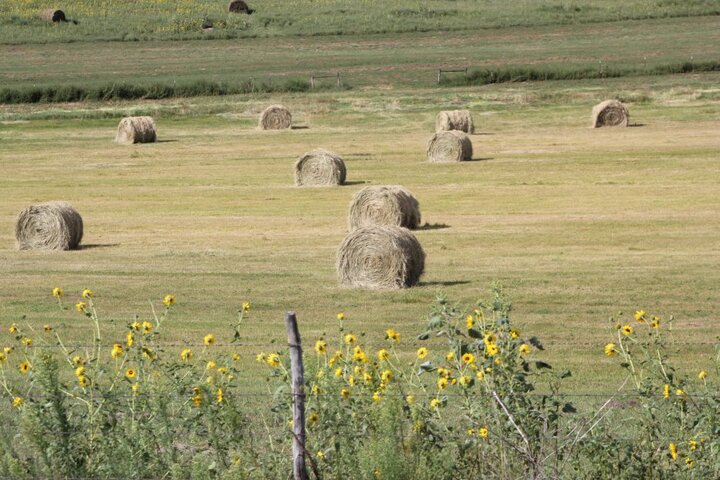As supplementation costs continue to rise across Nebraska, producers are looking for economical ways to meet protein and energy requirements of their cattle. Hay produced on irrigated grass and subirrigated meadows can be a potential supplementation source throughout Nebraska.
In this article, I will not attempt to assign a definitive feed value to meadow hay as it fluctuates from year to year, from region to region, and from pasture to pasture. Crude protein (CP) does typically range between 6% and 13% Dry Matter Basis with energy (Total Digestible Nutrients (TDN)) ranging between 50% and 65% on a Dry Matter Basis. That is a wide spectrum. The side of the spectrum that your hay will fall under can be greatly influenced by management inputs and timing of harvest.
Many native meadows tend to be dominated by cool-season grasses; as such, nutritive values tend to be highest in early summer (June). However, many producers do not harvest until early or mid-July either because sub-irrigated meadows are still too wet to access, or because they are trying to capture increased biomass.
Though both arguments are valid, if environmental conditions permit, June harvest should be considered if improved hay quality is the main objective. Though seemingly insignificant in terms of time, the weeks between the end of June and early July see a dramatic drop in quality of forages. Cool- season grasses are beginning to mature, elongate, and put up lower quality stems and seedheads.
In a small study conducted at the University of Nebraska’s Barta Brothers Ranch, I measured meadow hay quality and quantity over the course of a growing season. In mid-June average CP of meadow grass was approximately 9% and by mid-July it had fallen to 6.5%. The change in June TDN to July TDN was less dramatic as it fell from 62% to 61%, however, by August average TDN had fallen to 56%. Data collected at the University of Nebraska’s Gudmundsen Sandhills Laboratory (GSL) also indicate a similar trend in decreasing quality as the hay season progresses.
An earlier June harvest also presents an opportunity to utilize more meadow regrowth. In the Barta Brother’s study, quality of regrowth was measured in mid-September. Due to cooler late summer temperatures in 2018 and the dominance of cool season vegetation, quality in mid-September rose to 8% CP and 58% TDN. Additionally, because of previous harvest, regrowth of vegetation is predominately leafy material instead of stem which improves overall palatability.
Though quality is more affected by time of harvest as shown above, fertilizer application to meadows is a method to increase hay yield and potentially improve quality. In the Barta study, fertilizer applied at rates of 80 lbs/acre Nitrogen and 40 lbs/acre Phosphorus (80N 40P), 40 lbs/acre Nitrogen and 40 lbs/acre Phosphorus (40N 40P), 40 lbs/acre Nitrogen (40N), as well as unfertilized control plots were compared over the course of the growing season. The higher fertilizer rate of 80N 40P on average produced nearly 1000 lbs/acre more forage compared to control plots and nearly 200 lbs/acre more forage to the next closest fertilizer treatment.
The most effective fertilizer treatments in terms of improving quality were the applications of 80N 40P and 40N. The 80N 40P treatment resulted in an average CP and TDN content of 7.3% and 58.5% respectively over the course of the season compared to a 5.6% and 58% in the control. The 40N treatment resulted in an average CP and TDN content of 7.1% and 60% respectively over the course of the season compared to a 5.6% and 58% in the control. However, the quality of 40N regrowth was less than the higher application rates of fertilizer as well as the control.
Economically speaking, 40N/acre was the most attractive in terms of CP gained in forage compared to the control based on central Nebraska spring fertilizer costs. It cost $12.14 for each additional percentage of CP gained over the control for the 40N fertilizer treatment per acre. The most expensive was the 40N 40P treatment costing $41.25, with the 80N 40P being slightly less at $36.25. Costs for each additional pound of forage produced per acre was comparable between treatments ranging between $.04 – and $.07 for each additional pound over the control.
Is fertilizing an economical way to help meet nutrient requirements of cattle? It depends on the year and variations in costs. Haying operation costs, alternative forage production costs, fertilizer costs, and alternative purchased feed source costs constantly change and will need to be examined on a regular basis.
Fertilizer’s greatest value is increasing yield, while timing of harvest seems to have the greatest influence on quality. A good option is to utilize both. Optimize quality by earlier harvest, offset yield losses through fertilization, and capture quality, palatable late season regrowth. Also, utilize hay probes to test the quality of your hay as it may change from year to year and pasture to pasture.
Interviews with the authors of BeefWatch newsletter articles become available throughout the month of publication and are accessible at https://go.unl.edu/podcast.

